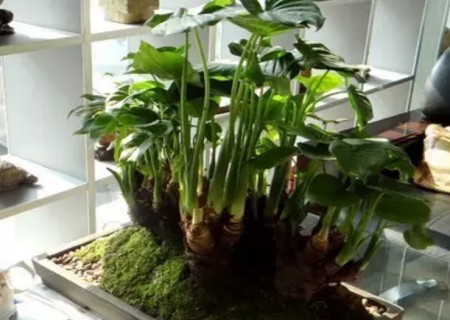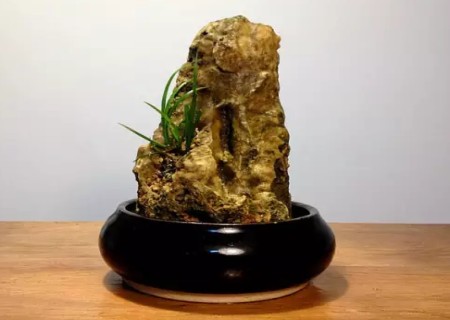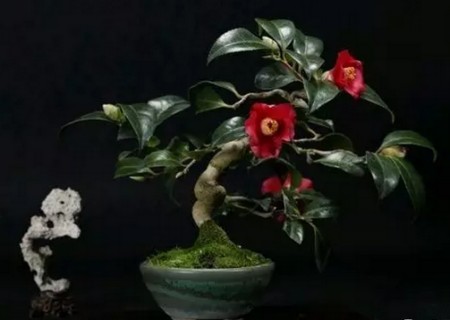The production method of Dishui Guanyin bonsai
Dishui Guanyin, also known as Taro, Guanyinlian, Amorphophallus, etc., is a large evergreen herb of the Araceae family. It originates from the virgin forests of Southeast Asia and Australia, and is also found in South China and Orchid Island. It needs to spend the winter indoors in northern China and can grow in open fields in the south. Corms and leaves can be used medicinally but are highly toxic.
Dishui Guanyin is native to the humid rainforest of Southeast Asia. It likes scattered light and does not like direct sunlight. It should be placed in a shaded place in spring and autumn, in a shaded place in summer, and indoors in winter. If the sun is too strong, the leaves will turn yellow by sunburn. But "all things grow by the sun", for a long time in the living room, bedroom and other places, due to lack of light or no light, will affect plant growth and morphological construction, in this condition, the plant Internode is particularly long, the leaves are underdeveloped and small, lack of chlorophyll and show yellow.

In addition, dripping Guanyin likes high temperature and humidity, properly apply some fertilizer and pay attention to more watering to increase its resistance to the environment and keep the leaves green.
Dripping Guanyin keeps the basin soil moist, exposing the roots a little bit, and watering the basin soil dry and thoroughly at one time. Cut off the roots if the leaves are yellow and be careful not to hurt other leaf diameters.
We usually maintain Dishui Guanyin as potted plants, but if we do bonsai, how should we make it? Here is the method of making Dishui Guanyin bonsai.
1. Matrix preparation
The nutritious soil was made of domestic peat with good looseness, drainage and aeration, 2 ∶ 2 ∶ 1 pond mud, peat soil and coarse sand mixed with a small amount of retting cake fertilizer, and the peat was mixed with water. (standard of adding water: after mixing well with water, hold a handful of peat tightly and water seeps from fingers) to be planted in cup.
2. Upper basin
The old pots that are reused must be soaked in potassium permanganate 2000 times solution for more than half an hour, then rinsed with clean water and dried for use. Large potted plants are generally used for 20cm pot planting, when planting, first in the bottom of the cup cushion 4cm around the matrix, and then move the sieve seedlings into the cup, seedling planting should not be too deep, flat planting base is appropriate; medium tightness, loaded to the cup 8 minutes full, 2-3 plants / pot.
3. Spray water
Dishui Guanyin especially likes to be wet. During the growing season, not only the basin soil is wet, but also the air humidity is not less than 60%. When it is hot in summer, it is necessary to strengthen water spraying to create a relatively cool and humid environment, which is placed in the indoor air-conditioned hall, not only to ensure that the basin soil is moist, but also to spray water on the leaf surface from time to time. If the room temperature can not reach 15 ℃ in winter, watering should be controlled, otherwise it is easy to cause rotting roots. In general, spraying warm water once a week can keep the leaf color thick green.
4. Fertilization
Dishui Guanyin prefers fertilizer. Liquid fertilizer should be applied every half a month from March to October, in which the proportion of nitrogen can be appropriately increased. If you can add a little ferrous sulfate, the leaves will grow as big as lotus leaves, smooth and pleasant. Fertilization should be stopped when the temperature is below 15 ℃.
5. Pruning
Because Dishui Guanyin is a foliage plant, in the case of improper planting and maintenance, the largest leaves will turn yellow and dry. At this time, they should be cut off with a knife together with the stem, otherwise it will affect the growth and ornamental quality of other leaves.
6. Change the basin
It can be cultivated in nutrient soil mixed with rotten leaf soil, peat soil, river sand and a small amount of retting cake fertilizer, or hydroponic, but attention should be paid to anti-rotting roots and adding nutrient solution. Usually change the basin once a year in spring, but loosen the soil once a month to keep the basin soil in a good state of permeability.
Note:
1. The white juice in the stem of dripping Guanyin is poisonous, and the dripping water is also poisonous. accidentally touching or eating its juice will cause discomfort in the pharynx and mouth, and there is a burning sensation in the stomach. Special attention should be paid to preventing young children from eating by mistake. But Dishui Guanyin is not a carcinogenic plant.
2. Dripping Guanyin is poisonous. Itching or strong irritation will occur when the skin touches its juice. Eye contact with juice can cause severe conjunctivitis and even blindness. If you eat stems and leaves by mistake, you will have symptoms of nausea and pain, and in serious cases, you will suffocate, resulting in heart paralysis and death. Therefore, exposure to Dishui Guanyin should be reduced as much as possible. Families with children had better not plant.
Time: 2019-05-26 Click:
- Prev

The method of making bonsai of Acorus calamus
Elegant vanilla, especially the money calamus and tiger-bearded calamus, the plant type is small and lovely, and the country breath is concentrated between the palms. Acorus calamus is as green as jade in the four seasons, simple and elegant natural, wild and elegant fragrance, fragrant heart, not only loved by the literati of all ages, but also loved by ordinary people in contemporary times. Seven vulgarity in Jiangnan: playing the guqin
- Next

How to make tea plum bonsai
Camellia is an evergreen shrub of the family Theaceae, which is called Camellia because its flower pattern has the characteristics of both camellias and plum blossoms. In the Ming Dynasty, Gao Lian wrote a song "Plum Blossom Ling Tea Plum": the flower is, with Meihun, a few strokes, writing the charm of tea plum, both like camellias and plum blossoms.
Related
- Fuxing push coffee new agricultural production and marketing class: lack of small-scale processing plants
- Jujube rice field leisure farm deep ploughing Yilan for five years to create a space for organic food and play
- Nongyu Farm-A trial of organic papaya for brave women with advanced technology
- Four points for attention in the prevention and control of diseases and insect pests of edible fungi
- How to add nutrient solution to Edible Fungi
- Is there any good way to control edible fungus mites?
- Open Inoculation Technology of Edible Fungi
- Is there any clever way to use fertilizer for edible fungus in winter?
- What agents are used to kill the pathogens of edible fungi in the mushroom shed?
- Rapid drying of Edible Fungi

